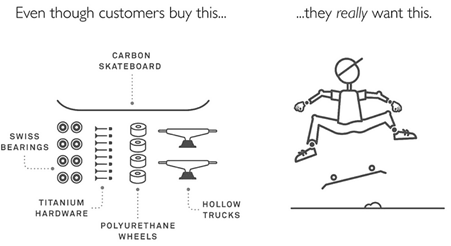Understanding your customers ‘Jobs to be Done’
Understanding what drives customers to choose one product or service over another is crucial for product innovation and business growth. The Jobs to Be Done (JTBD) framework offers a unique lens through which businesses can view customer needs, focusing on the underlying reasons customers hire a product or service to accomplish a specific job.
“A Job to be Done is the process a consumer goes through whenever they aim to change their existing life-situation into a preferred one but cannot because there are constraints that stop them.” – Alan Klement, Medium
This perspective emphasises the customer’s journey and the constraints they face in achieving their goals. It’s not just about what the product does, but why the customer needs it.
A 2016 poll of global executives found that 84% believed that innovation was extremely important to their growth strategies, yet “a staggering 94% were dissatisfied with their organisations’ innovation performance.” This dissatisfaction often stems from a lack of understanding of customer needs and how to meet them effectively.
The JTBD framework, championed by Clayton Christensen, suggests that customers ‘hire’ products and services to get a job done. This perspective shifts the focus from demographic segmentation to a deeper understanding of the functional, emotional, and social dimensions of customer needs:
- Functional Jobs: Practical and task-oriented aspects of what the product does
- Emotional Jobs: How customers feel about doing the job
- Social Jobs: How customers want to be perceived by others while using the product
By focusing on these dimensions, companies can innovate more effectively and align their offerings more closely with customer desires.
Uncovering JTBD requires a blend of qualitative and quantitative research methods. Essential tools often include:
- Customer Interviews and Observations: Direct interactions with customers to understand their needs and challenges
- Surveys and Focus Groups: Collecting data from a broader audiences to identify common patterns
- Analysis of Feedback and Complaints: Understanding what customers like and dislike about current solutions
Several organisations have successfully applied the JTBD framework to revolutionise their industries. For example, McDonald’s used this approach to understand why customers were buying milkshakes and discovered that they served as a convenient breakfast on the go (as discussed by Christensen). Similarly, Airbnb identified that travellers were seeking unique and authentic experiences, not just a place to stay. By focusing on this job, Airbnb transformed the travel industry, offering a platform that connects travellers with local hosts, providing a distinctive and personalised experience.

Source: intercom.com
Implementing the JTBD framework generally involves a combination of the following steps:
- Conduct Thorough Research: Identify the jobs your customers need to get done. This research should go beyond surface-level needs to uncover the deeper motivations and desired outcomes.
- Segment Your Market Based on Jobs: Move away from traditional demographic segmentation to a more nuanced understanding of customer needs based on their jobs.
- Design Your Products and Services: Align your offerings with the identified jobs. Ensure that your value proposition clearly communicates how your offering helps customers get their job done better than alternatives.
- Communicate Effectively: As the founder of Revlon eloquently puts it, “In the factory we make cosmetics; in the drugstore we sell hope.” This perfectly surmises the difference between what customers buy and why they buy it, capturing the essence of the JTBD framework and the need to market to consumers effectively
The JTBD framework offers a powerful approach to understanding and meeting customer needs. By focusing on the jobs customers hire products to do, businesses can innovate more effectively, create more targeted solutions, and ultimately drive growth.




